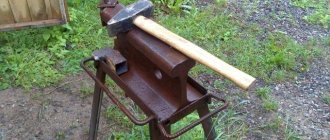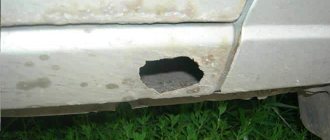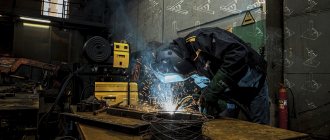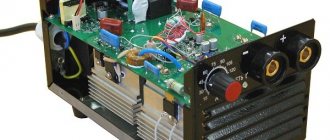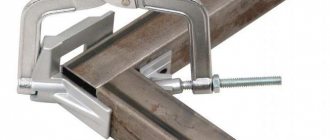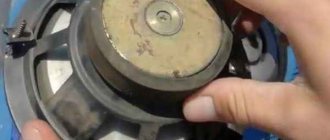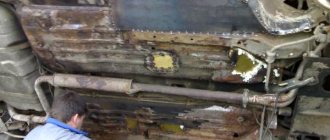Borax is a high-temperature flux produced in powder form and used when joining metal parts by soldering. Borax soldering flux melts at a temperature of 700 degrees Celsius, which is why it is called high-temperature flux.
Borax has its own GOST that regulates its composition and production. According to this GOST, borax should dissolve in water and, when solidified, turn into a transparent mass. In this article, we will tell you everything about borax powder.
Advantages of soldering borax
- Copper borax is one of the few widely available fluxes for refractory metals;
- The cost of the material is relatively low in comparison with other materials of this kind;
- It is possible to dilute borax to the desired consistency in water, since it has good solubility;
- Flux is available in almost all stores and there are no problems finding a suitable brand;
- Long shelf life.
This is interesting: Welding aluminum - how to properly weld aluminum at home
What is it and what is it for?
Soldering borax is a high-temperature type of powdered flux that is used when joining metal products by soldering. Melting of this substance can occur under the influence of temperatures exceeding 700 degrees Celsius. Soldering borax has its own GOST, according to which it is manufactured and its characteristics are regulated.
The substance in powder form looks very similar to salt, in other words it is called sodium tetraborate. The synthesis of borax occurs naturally, and its extraction is carried out from salt lake deposits.
The use of this substance is quite wide, but most often it is used for soldering copper pipes.
The advantages of using borax include the following:
- the materials that are planned to be processed may have different temperature conditions;
- obtaining a high-quality, reliable weld not only between metals, but also between metal and non-metal surfaces;
- ease of soldering seams if necessary to separate parts;
- when soldering, the parts do not warp or deform;
- increased productivity during capillary soldering;
- obtaining smooth and durable seams even from a craftsman with little experience.
The disadvantages of sodium tetraborate are as follows:
- release of a large volume of salts, which harden on the metal at high speed;
- absorption of moisture from the environment;
- the difficulty of selecting the right amount of borax for an inexperienced welder.
Usage
Before connecting parts, you need to pay attention to their preparation. The latter is in the following sequence:
- Clean the joints of the elements from dirt and corrosive damage using a scraper with coarse bristles. The flux itself will deal with the oxide film on the surface.
- Use a blowtorch flame to heat the joints of the structures to be welded.
- During heating, leave a gap of at least 1 mm between the elements.
- Introduce borax with solder into the gap, also heated by a lamp, while continuing heating.
- When borax crystallizes, turn off the blowtorch.
- After the parts have cooled, remove salt deposits with a brush.
The first soldering with borax may not be successful due to the small amount of the substance. It is recommended to select it practically. To improve the seam, you can use boron flux with the addition of fluoride or chloride elements.
Application of brass and copper powder
Practitioners often use flux that has been stored longer than expected. To solder with brass, the borax must be re-melted. The cooled powder should be placed in a jar with an airtight lid. Neglecting this procedure can ruin the work due to waste accumulated during storage.
At the beginning of soldering, the working area must be heated to a clearly visible red color . Heating should begin first at the edges, and then directly at the soldering site.
Then the heated area should be gradually sprinkled with flux, wait until it spreads in the form of a film along the edges of the part. At this point, the heated brass solder must be dipped into the molten borax so that it is covered with a hot flux film.
As experience shows, the soldering area is red in color, while the borax melt is colored bluish. You cannot keep solder in the flux for a very long time. Oxide residues may form.
Then you should warm up the work area again. The brass will take on an orange glowing appearance. You can proceed directly to soldering. If done correctly, the solder will fill all the gaps.
The soldering area will turn golden. When the process is completed, the hot zone should be sprinkled with borax powder and left to cool. Copper parts in a hot (200 ℃) state can be placed in a mixture containing equal parts acetone and water, or simply in water. It makes sense to immerse the cutters in hot sand.
A correctly made connection has a transparent film with a slight blue tint. There are no solder drops on it. If soldering is performed incorrectly, the seam becomes covered with a black porous crust.
The reason may be overheating of the working area, as a result of which slag is formed, or poor quality of borax-based flux. This is how brass and other copper-containing alloys are soldered.
How is the soldering process performed?
When performing soldering at home, you need to understand one subtlety. When borax has been stored in powder for a long time, it is better to melt it first, for which a crucible or fireclay is used. The resulting substance should be crushed into a powder and placed for storage in an airtight container.
Tightness is a prerequisite: the powder is hygroscopic, and due to the presence of moisture in the flux, slags with metal can form.
Before applying flux, the soldering area is heated red-hot. It is better to heat not the soldering area itself, but next to it, gradually transferring the heat to the junction of the elements. When the parts have warmed up, the joint should be sprinkled with a small amount of borax. At the same time, monitor the temperature, wait until the borax melts well and spreads over the soldering area in the form of a film.
It is better to solder with brass, the rod is dipped in borax, after which you need to wait for the powder to melt. The flame that the soldering torch emits should be close to the soldering area, but you don’t need to hold it like that for long. This way you can get a connection with slag and a layer of scale, which will be difficult to remove. Immediately before the solder is applied, the soldering area should be red and the melted borax should be bluish. This moment can be considered optimal for adding solder.
Next, a solder bar coated with borax powder must be brought to the soldering site and heated to the temperature at which the solder begins to melt (in the case of brass, until it glows orange). The melting point of brass and borax is almost the same. Next, the actual work process begins.
Read also: How to check a level in the field
Composition and properties
The chemical nomenclature of soldering borax indicates that it is a crystalline hydrate of the sodium salt of tetraboric acid . If the substance contains 10 water molecules, then it is called sodium tetraborate decahydrate. In simple words, it is a salt that is surrounded by a shell containing 10 or 5 water molecules .
A temperature of 64 degrees causes decahydrates to melt and lose water in the process. Borax is dehydrated at a temperature of 380 degrees Celsius. Tetraborate is characterized by withstand heating up to a temperature of 742 degrees and melting when it increases.
Borax contains sodium chlorine, barium chlorine and, in some cases, boric acid. Flux in the form of a solution has a high ability to dissolve metal oxides, as well as fatty films and anything unnecessary that can prevent the adhesion of materials.
Thanks to the use of borax during soldering, many products are produced without defects.
This is interesting: Step (conical) drill for metal: selection, application, sharpening
List of required components
There are several options for preparing sodium tetraborate yourself. For the simple method you will need:
- baking soda;
- boric acid;
- plastic container;
- wooden stick;
- napkin.
The second method involves longer production times. It will require:
- construction borax (this is what a solution of boric acid is called in a pharmacy);
- glycerol;
- plastic container.
Read also: How long a gas hose can be used
How to make sodium tetraborate yourself at home using these components, megamaster.info will tell you below.
Kinds
Based on appearance, welding drills are divided into 2 types.
- Solid . In powder form, flux has the form of solid fine fractions. This shape makes it easy to lay borax on a metal surface before the soldering process, while the substance does not spread. Solid borax is sold in boxes that are sealed, thereby protecting the substance from moisture and the negative influence of the environment. In the powder fraction, borax is white.
- Divorced. This type of borax is considered the most suitable for light metal and its alloy. The substance is the same powdered borax, but dissolved in a liquid. This feature of the flux makes it possible to use it at low soldering temperatures. Using diluted borax is quite simple: small metal elements are dipped into it and then soldered. This flux is popular in jewelry, as well as when working with wires and contacts.
Method for producing flux for forge welding
FOR THE AUTHOR'S CERTIFICATE
Registered in the Bureau after the inventions of the State Planning Committee under the Council of People's Commissars of the SS
Method for making flux for forges
Declared on March 2, 1938 to NKTMash as No. 14
Published July 31, 1939.
Type. art. "Owl" pence" Zak. ¹ 6010 – 675
The subject of the invention is a method for producing a flux for forge welding, used instead of borax.
To do this, freshly calcined quicklime is mixed with water at the rate of 0.3 wt. hours of lime for
1 wt. parts of water, and 1.3 parts by weight of lye, preferably sodium carbonate, is poured into the resulting lime milk. When standing for several hours at room temperature, the mixture hardened. works and in a crushed state can be used as a flux for forge welding.
In addition, you can pour the solid product obtained in this way with well-settled and boiled lime water, and the amount of the latter by weight should be 1 part per 2 parts of the solid substance.
After standing for several hours, this mixture turns into a fine powder, which has even better qualities as a flux than the originally obtained product.
A method for producing flux for forge welding, characterized in that 0.2 - 0.3 wt. tsp quicklime, dissolved in 1 wt. parts of water, mixed with 1.3 wt. including lye to form a solid, which gradually turns into powdery flux.
Source: findpatent.ru
Popular manufacturers
Soldering borax is sold under two brands:
- A – used when working with non-ferrous metals, frit, earthenware and others;
- B – indispensable for enamel, glaze, technical equipment, wire and plumbing elements.
Popular manufacturers of this substance today include Rexant, ZUBR, Latus and others . These products are in good demand among consumers, as they have high quality characteristics and an affordable price.
Buisky Chemical Plant, KhimPek and Xiamen have also proven themselves well.
Advantages and disadvantages
The advantages of drill flux include:
- availability and low price compared to similar materials;
- no deformation of parts, since the base metal does not melt;
- connection of metal with non-metal;
- the ability to solder parts with different initial temperatures;
- ease of desoldering during dismantling;
- increasing the productivity of capillary soldering;
- high quality seams, made even by a beginner;
- long shelf life of flux.
Disadvantages include :
- the need to mechanically clean the surface from salts that are released when the borax is heated and, after cooling, settle on the metal;
- high hygroscopicity, so the flux becomes damp even in a tightly closed container;
- the difficulty of determining the optimal proportion for beginners.
Sodium tetraborate for slime
The substance sodium tetraborate is found in the children's entertainment toy slime. Knowing how to make sodium tetraborate at home, you can make a toy for your child from the substance. It will be no different from the store-bought version, but since it is a chemical, it is advisable to play with it carefully.
Homemade slime for your child will have more significant advantages compared to purchased options. To make a toy yourself, you first need to make a borax solution, and also prepare glue (preferably transparent), water and gouache, you can use food coloring.
Slime making process:
- find a container and pour warm water into it;
- add the prepared borax solution and mix the composition well;
- after dissolving the substance, we find another container and pour half a glass of water, glue and dye into it, and then also mix as much as possible until a homogeneous mass of the same color is obtained;
- now the mixture is poured in a thin stream into the container with the dye, but at the same time you need to mix the composition;
Ready slime
The result is a viscous mass that a child can play with, but you need to control it so that the baby does not put the slime in his mouth.
We discussed other options for making a child-safe slime toy in a separate article.
Where and how is borax used?
From a chemical point of view, borax is a sodium salt with the complex name “sodium tetraborate decahydrate”. With its participation as an active element in the protective flux mixture, a wide variety of metals are combined, up to complex and capricious alloys, for example, copper.
According to this technology, additional metal solders are used for joining; they can also be of different compositions.
Tools and consumables for soldering.
At a high temperature, the borax begins to melt, as a result of which the surfaces to be welded are cleaned with the simultaneous dissolution of oxides in the hot flux mixture.
The essence of this process is the formation of salts followed by surface crystallization. This crystalline deposit is easily removed after the welding process.
Varieties
According to its appearance, borax is divided into 2 types:
- Solid in the form of a fine-grained white powder. Sold in sealed packaging to protect against moisture. It is convenient to apply the powder in the required quantity to the surfaces to be joined, since the flux does not spread.
- Diluted. This is borax dissolved in liquid, which can be used for soldering non-ferrous metals at low temperatures. Small parts are simply dipped into the solution, which is convenient when working with jewelry, wires, and electrical appliance terminals. In terms of efficiency, diluted flux is almost equal to solid flux.
Depending on the quality, the brand is designated by the letter:
- A - consists of 99.5% decahydrate and 0.5% impurities. Used for frit, earthenware, etc.
- B - impurity content up to 6%. Used for working with glaze, enamel, and plumbing equipment.
Composition of borax
For soldering, it is better to use grade B, as it meets all requirements. And the price is less.
The shelf life of both brands is no more than 6 months.
Warm it up thoroughly
The parts are heated in furnaces or furnaces. The amount of fuel must be precisely calculated - no more and no less. The best fuel for forging is charcoal and coke. But in practice, ordinary coal is more often used.
Metal parts are loaded into the forge only after the coal has completely burned out, so that sulfur is removed from it, the presence of which has a bad effect on the quality of the compound.
The heating temperature of the parts must be higher than the level at which forging begins. The level of heating temperature in figures depends on the percentage of carbon in the steel: the lower its content in the alloy, the higher the heating temperature must be raised to melt.
For low-carbon steel, heating should be no lower than 1350 - 1370°C, the distinguishing feature is the shining white color of the metal. If the steel contains a high proportion of carbon, heating to about 1150°C is sufficient, the color will then have a yellow tint.
Forge welding flux is added for protection. It's all about the abundant formation of scale due to heating. Flux mixtures protect against this. Flux for forge welding is poured at a precisely designated moment - when the heating level is between 950°C and 1050°C.
The basis of the mixture is fine clean river sand with the addition of 10% borax after good calcination. Borax in sand promotes good slag formation and easy cleaning of metal from impurities in the future.
Peculiarities
How to use borax in your work to get the highest quality results? To answer this question, we will talk about all the stages of soldering using borax. First of all, you need to prepare the metal. Clean it from dirt and corrosion. Pay special attention to stubborn stains; they must be removed with a rough brush. The oxide film does not need to be removed, since the borax will handle it itself.
Then, using a blowtorch, you need to heat the surface of the parts to be welded. Leave a small gap between the pieces. Add borax and solder into it, preheated with a blowtorch. Once the borax begins to crystallize, you can stop heating. When borax hardens, it becomes transparent and forms a lot of salts. Remove them from the metal surface. It is important to follow the sequence of operations and not to overdo it with the amount of flux. It's hard to say how much borax to use because it depends on the metal and the weld you want to create. Experiment and with experience you will begin to understand which dosage is preferable. Borax can be used in powder form, or you can make boron flux from it. Boric flux is widely used for soldering copper pipes and cast iron parts. Mix boric acid and borax in a one to one ratio. Then you need to crush the resulting mass in a bowl, and then evaporate it, getting rid of excess liquid. Fluoride and chloride salts are added to the dry residue. Boric flux is ready! It has active properties, allowing you to solder copper parts faster and with better quality.
Step-by-step instruction
To prepare a solution of borax from soda and boric acid, follow these steps:
- pour boric acid into a container;
Tetraborate from soda. Pour boric acid, add 1 teaspoon of soda to the acid;
Stir
- stir the mixture until the soda is completely dissolved;
- strain the finished mixture through a napkin to remove any remaining soda
What you get as a result is sodium tetraborate. Which can be used for its intended purpose.
To prepare a borax solution according to the second recipe, you will need:
pour 1 teaspoon of boric acid (borax) solution into a container;
Construction borax for tetraborate, add 4 teaspoons of glycerin to the powder;
Adding glycerin
Sodium tetraborate after microwave
The result is clear sodium tetraborate. Please note that the resulting solution is a chemical product and cannot be used for medical purposes. This sodium tetraborate is ideal for making handgam.
Soldering of metals is carried out by first removing traces of oxides from their surface. Fluxes are used for this. They should prevent oxidation when heated and encourage good flow of molten solder.
For soldering copper products, borax solder ideally meets all requirements. The substance has been known since the Middle Ages. It was mined in the lakes of India and Tibet, then transported to Europe, where it was used for processing fabrics and leather, and producing glass.
Borax is widely used for working with metals. When manufacturing or repairing metal products, borax soldering is carried out. First of all, the method is used for parts made of copper and brass. A special type of this flux is used when repairing jewelry.
Areas of application
Borax, which is a salt containing a weak boric acid and a strong base, also has a scientific name - sodium tetraborate decahydrate. Using this substance, used as a flux, soldering of metals such as steel, cast iron, copper and its alloys is performed. In this case, for such soldering, medium-melting solders are used, the basis of which can be copper, brass, silver and gold.
When borax melts, which occurs at a sufficiently high temperature, the surfaces of the parts to be joined are cleaned, and the oxides that are present on them dissolve in the heated flux. During the soldering process, for which a refractory flux such as borax is used, which meets the requirements of GOST 8429-77, salts are formed that crystallize on the surface of the joint being formed. After completion of the technological operation, salt deposits must be removed.
GOST requirements for the composition of borax-based flux
To obtain boron flux from borax, which can be used when soldering parts made of copper, cast iron, steel and other metals, this substance must be mixed with boric acid in a 1:1 ratio. The resulting mixture is thoroughly ground in a porcelain container, and then the excess liquid is evaporated to obtain a dry residue, to which fluoride and chloride salts are added. Using this technology, active fluxes are obtained that allow high-quality soldering of parts made of various metals.
You can familiarize yourself with the GOST requirements for technical borax (sodium tetraborate) by downloading the document in pdf format from the link below.
GOST 8429-77 Borax. Specifications Download
Description and external signs
Borax mineral is an aqueous sodium borate with hydroxyl. It is also popularly known as boric salt. In Asian countries it is called tincal. This substance resembles almost colorless crystals. Origin of the name: from the Arabic word bauraq - translated as “white”. The form of release of borax in pharmacies and hardware stores is a white fine-crystalline powder.
Chemical composition
The components of borax are the sodium salt of boric acid and a strong base (water, sodium). Chemical formula: Na2(B4O5)(OH)4 8H2O
The practical significance of borax is to serve for the extraction of boron.
Molecular weight of the substance: 381.37; Density: 1.7; Specific gravity: 1.69 – 1.8; Maximum birefringence: δ=0.025; IMA classes: borates.
Advantages of using borax in working with metals
These advantages are especially evident in the processes of soldering brown copper pipes, which are often important components of modern pipelines. Such technologies are now in great fashion.
They are used both for connecting new pipes and for high-quality repairs of old pipelines that have been in use for a long time.
The most important role of borax in the flux composition is to remove the oxide film from the metal surface and activate the spreading of liquid solder over the surface of parts.
Technical requirements for fluxes.
Here are its technical advantages:
- Metal parts in any, even the most “inconvenient” combination can be merged.
- The connections are strong and reliable even between metals and non-metallic materials.
- Work can begin with metals having any initial temperature.
- Using this technology, parts can not only be connected, but also effectively separated - they can be unsoldered without any problems.
- The difference between soldering and classical welding is that the base metal does not melt, and therefore there is no phenomenon called “warping”. As a result, the parts are not deformed in any way.
- Borax helps in effective adhesion of solder to metal surfaces.
- Technical drill is indispensable for the method called “capillary soldering”: it affects its performance.
- Soldered joints are characterized by high quality and durability.
Areas of application of sodium tetraborate
Sodium tetraborate has found a wide range of applications. It is often used in a wide variety of fields. Many people know how to make sodium tetraborate at home, but do not know what and where else it is used.
This substance is actively used in the following industries:
- Industrial. During the manufacture of metal elements, in factory conditions, the substance is used during welding. In this case, it is a component of the flux. Sodium tetraborate is also actively used in the manufacture of materials such as glass, glaze and enamel coating. Borax solution is in demand in the mechanical engineering industry. It is added in the manufacture of antifreeze, brake fluids and various machine lubricants.
- Textile production. In this case, sodium tetraborate is used to treat the fabric before dyeing it in the desired color.
- Jewelry industries. In the manufacture of jewelry, this substance is used as a flux, which is simply necessary when soldering jewelry elements. Also, with the help of sodium tetraborate, the surface of the precious metal is cleaned and thus the highest quality connection is achieved. Mainly in this industry, this type of component is used for processing brass, silver and gold products.
- Medicine. Sodium tetraborate is actively used to combat various types of fungi. To do this, experts prescribe medications that contain glycerin and sodium tetraborate. Doctors believe that this substance is a high-quality antiseptic and its characteristics are better than copper and tannin sulfate. Pharmacies sell a substance called boric acid solution.
- Cosmetology. Almost every product used in modern cosmetology contains sodium tetraborate.
In this case, in some cosmetics the substance softens water for masks and extends the shelf life of cosmetics.
- Soap making and home life. The substance is a component of bath bombs. It is due to its presence that, upon contact with water, the bomb begins to hiss and release bubbles. At home, sodium tetraborate is often used as a poison for insects, and is also used as a cleaning agent and in the role of other substances with various purposes.
Sodium tetraborate in everyday life
Knowing how to make sodium tetraborate, you need to know what it can be used for at home. In some cases, a substance may simply become irreplaceable.
At home it is often used as:
- A detergent that can clean any surface. To use this substance for cleaning a room, you must first prepare it. To do this, you need to dissolve 2 teaspoons of borax solution in several glasses of water. To use the substance as a detergent, you need to dissolve 2 teaspoons of a water solution in 200 milligrams of water. After this, the composition is filled into a spray bottle, which can be taken from an empty window cleaner, and during wet cleaning, it is necessary to add the product to a container of water. Using a borax solution in your home will keep your room sparkling clean. And knowing how to make sodium tetraborate at home, you can save money on purchasing ready-made compounds.
- Means for removing rodents and insects from living quarters. Surely every apartment owner knows the old-fashioned method of fighting cockroaches and other insects, organizing which involves making balls of potatoes, egg yolk and boric acid. This mixture is poisonous and perfectly protects the apartment from the appearance of cockroaches. But when using such balls, it is important that insects do not have access to water. If they get the water, your efforts will be in vain. If you live in a private house and suddenly find mice, then sodium tetraborate powder must be scattered along the baseboards. Using this method, rodents will leave your cozy den.
- Substances for removing mold and fungi. Mostly, mold and mildew appear in a damp room, which in any house or apartment is the bathroom. Knowledge of how to make sodium tetraborate will come to your aid in this case. The finished composition can be applied only to those surfaces where there are no coloring materials. If you use the mixture on a painted base, the paint will simply peel off. Having prepared the solution, it must be mixed with water, but in such a way that the result is a thick consistency that is similar to toothpaste.
- The resulting mass is applied to the location of the mold and left overnight. In the morning, the mixture can be removed and only a clean surface will remain in place of mold or mildew. Of course, you can remove mold by drying the area and washing it, but an effective way is to use sodium tetraborate, which will remove fungus and mold for a long time.
- Composition for removing dirt from plumbing fixtures. In some situations, even the most expensive chemicals and detergents cannot remove limescale deposits on the surface of a sink or toilet. Just for such cases, sodium tetraborate is used, which does not have to be purchased, but can be made independently. To do this, just study the material on how to make sodium tetraborate at home. To remove plaque, you need to pour the prepared mixture in the amount of one glass onto the surface of the earthenware product, wait overnight and clean the surface with a brush in the morning. After this, you will be convinced that the plaque that expensive products could not cope with simply disappeared and left absolutely no traces behind.
Of course, the substance can be purchased at a pharmacy, and the powder at construction sites. But it is much cheaper and more convenient to prepare it yourself. Knowing how to make sodium tetraborate, you will not spend a lot of time and money, because it is made quite quickly and from available material.
Use in medicine
The substance sodium tetraborate is actively used in the medical field, as it has antiseptic characteristics, perfectly fights fungal diseases, and even suppresses thrush pathogens.
Medical experts say that sodium tetraborate prevents bacteria from attaching to the mucous membrane and stops the development of pathogenic microorganisms. It is also the main component of anti-inflammatory drugs that are prescribed for the treatment and prevention of respiratory diseases.
Read also: Hair dryer for welding polypropylene sheets
Sodium tetraborate with glycerin is used for external use, since in this case the active substance begins its effect immediately upon application to damaged areas of the body.
The substance penetrates the gastrointestinal tract through the mucous membrane and is then excreted from the body by the kidneys. The removal of the substance from the body takes about a week. The removal of the substance from the body takes about a week.
Glycerin in the composition of sodium tetraborate is an additional component that performs the function of moisturizing and promotes more effective penetration into the deep layer of the affected skin.
Often sodium tetraborate solution is used to treat:
- infectious inflammation of the genital organs – thrush;
- fungal infection of the oral mucosa - stomatitis;
- agranulocytic tonsillitis, during which necrotic tissue decay in the tonsils and throat spreads throughout the body along with the blood flow;
- an inflammatory process that occurs in the area of the palatine tonsils - tonsillitis;
- acute pharyngitis, in which the mucous membrane of the pharynx becomes inflamed;
- laryngitis, during which the tissues of the larynx become inflamed;
- urinary tract diseases;
- diaper rash and bedsores.
In metallurgy
Sodium tetraborate has a wide range of uses, but despite this, it is actively used specifically for soldering copper pipes. The connection of copper material using this substance is of high quality, reliable and durable.
Using sodium tetraborate, you can not only design a new pipeline system, but also restore the old one. A similar substance when soldering copper elements has a number of advantages, but there are also disadvantages when using the composition.
The main advantages of using sodium tetraborate when soldering copper pipes:
- the ability to solder elements at different temperatures;
- by using sodium tetraborate, you can achieve a high-quality connection of parts, even in the case when elements made of metallic and non-metallic materials are soldered;
- although the quality of the seams of the connected elements is high, if necessary they can be unsoldered;
- since melting sodium tetraborate requires a high temperature, many will think that the metal is not deformed, no, because the temperature at which the substance melts is not so high as to deform and spoil the material;
- better adhesion of solder to metal is ensured;
- a significant increase in productivity when soldering using sodium tetraborate;
- Even if a novice welder does the soldering, the seam turns out smooth and of high quality.
Despite the large number of advantages of soldering copper products using sodium tetraborate, there are also some disadvantages.
- the release of a large amount of salt during the melting of sodium tetraborate, and since they stick to the material they must be cleaned off at the end;
- the soldering agent has the ability to accumulate moisture from the surrounding area, even when the lid is tightly closed;
- A novice solder will need some time to obtain a high-quality seam, so it is necessary to first practice soldering using sodium tetraborate.
Stages of soldering with borax
The whole process consists of successive steps, the implementation of which is mandatory:
- Careful preparation of workpiece surfaces before heating.
- Cleaning is carried out to get rid of oxide films, this is where technical drill is needed.
- A blowtorch heats the surfaces to be welded to the desired temperature.
- Heated metal solder in a liquid state is introduced into the space between the parts.
- The essence of the connection is the combination of the base metal with liquid metal solder in a well-heated state.
- The process ends with the final crystallization of the solder.
What GOSTs regulate
Until 2009, forge welding was regulated by the document GOST 2601-84 “Welding of metals. Terms and definitions of basic concepts."
This version of the document defines forge welding as “furnace welding in which upsetting is accomplished by hammer blows.” GOST was put into effect on February 29, 1984. A reissue with changes was published in October 1996. The document has become invalid since 07/01/2010.
Active
Types of welding are now regulated:
- GOST R ISO 17659-2009 “Welding. Multilingual terms for welded joints.”
- GOST R ISO 857-1-2009 “Welding and related processes. Dictionary. Part 1. Metal welding processes. Terms and Definitions".
Both GOSTs came into force on 08/04/2009.
The first document defines the general section - pressure welding . This is “a welding carried out by the application of an external force and accompanied by plastic deformation of the mating surfaces, usually without filler metal.” The note specifies that “mating surfaces may be heated to facilitate the formation of the joint” (ISO 857-1).
But the second GOST gives a description of forge welding in paragraph 4.1.6.12 . It reads: “forge welding is pressure welding in which workpieces are heated in a furnace, and the seam is obtained as a result of blows with a hammer or the application of another pulse force sufficient to plastically deform the mating surfaces.”
Soldering copper pipes using borax
Borax application table.
First you need to stock up on the necessary tools and materials:
- blowtorch or gas torch;
- special solder, selected taking into account the nature of the metals that need to be soldered;
- borax with optimal properties according to GOST 8429-77;
- metal brushes for cleaning parts;
- metal cutting tool;
- brushes for coating parts with a flux layer.
The choice of gas burner deserves a special warning. The fact is that these devices are offered on the market in huge quantities and in different models.
A fashionable device in gas burners is an automatic piezo ignition system.
Our advice: you can choose a burner with it only if you are completely sure that the product was manufactured by a well-known and reputable company. If you are not so sure, it is better to buy a high-quality classic model.
And now the main stages of the soldering process using borax to connect two copper pipes:
- Thorough cleaning of the surfaces inside the pipes with special brushes with metal bristles.
- Now clean the outer surfaces of the pipes using sandpaper.
- Applying technical borax using a brush.
- Joining pipes that are coated with a flux layer to each other.
- Heating the parts with a gas burner. The flame action must last for at least 20 seconds.
- Solder is introduced onto the working area, which is also melted under the action of the burner. Solder is applied as evenly as possible.
Quality control of connections using borax flux is carried out using different methods: destructive and non-destructive. Most often, an external examination is sufficient to determine possible defects. You can even do this with a magnifying glass.
Forge welding and forging welding
Forge welding of metal is one of the oldest methods of obtaining a permanent connection. At the same time, using such a primitive method, you can connect a wide variety of metals, including stainless steel. But keep in mind that the weld is not strong enough, and this work is considered very labor-intensive. However, forge welding also has its advantages.
In this article we will briefly explain what the essence of forge welding is and what features need to be taken into account in order to comply with the technology.
Benefits of use
Copper pipes as components of pipelines for various purposes are very popular today. In this regard, brazing copper, which uses a flux such as borax, has become a fairly common technological process. The use of this method of connecting copper products allows not only the installation of new pipelines, but also high-quality repairs of those that have already been in use for a certain time.
Borax removes the oxide film from the surface and promotes the spreading of liquid solder
The use of technical borax as a flux when soldering copper has the following advantages.
- Metal parts in any combination can be subjected to high-quality soldering.
- Metal products that need to be joined by soldering can have any initial temperature.
- When using borax, high-quality and reliable connections can be obtained even between metal and non-metallic parts.
- Soldered joints made using this flux can be unsoldered at any time if the need arises.
- When soldering, the base metal does not melt, as happens during welding, which avoids such an undesirable process as warping (and, accordingly, changes in the geometric shape of the products being joined).
- The use of borax allows for excellent adhesion of the solder and the surfaces of the parts to be joined.
- Technical borax, used as a flux, provides high productivity for a process such as capillary soldering.
- The solder joints obtained using this type of flux are characterized by high strength, reliability and durability.
Brazed copper pipes using borax as flux
To understand what factors influence the quality of soldering, you should know the stages of this technological process. The soldering algorithm is as follows.
- The surfaces of parts that need to be connected by soldering must be carefully prepared.
- Contaminants are removed using standard means - brushes, rags, etc. And to remove refractory oxide films from the surface of parts, a flux such as technical borax is used.
- The surfaces of the products to be joined must be heated to a certain temperature, for which a blowtorch is used.
- Liquid solder is introduced into the gap between the parts to be joined, which is also heated using a blowtorch or a regular gas torch.
- The interaction of the heated base metal and liquid solder ensures a reliable solder joint.
- The soldering process can be considered complete at the moment when complete crystallization of the solder occurs.
» data-lazy-type=»iframe» src=»data:image/gif;base64,R0lGODlhAQABAIAAAAAAAP///yH5BAEAAAAALAAAAAABAAEAAAIBRAA7″>
Soldering brass - a reliable connection at home
A weighed portion of technical borax 0 4596 g, titrated with a solution of HC1 with R0 1062, 21 20 ml was consumed. [4]
Industrial drill supplied by industry contains hygroscopic and crystallization moisture, which, when entering the weld pool, sharply increases the gas porosity of the weld metal. In addition, part of the borax, when moisture evaporates from it, foams and is blown out by the flame, as a result of which areas of the metal are exposed and oxidized. [5]
Borax is obtained from common technical borax (Na2B4O7 - 10H2O) after calcination in an oven at a temperature of 700 - 800 C on a stainless steel baking sheet or in an open fireclay crucible filled with ciu in height at V, due to the strong swelling of borax when heated. After calcination, the borax is ground in a mortar or ball mill. This borax should be stored in a hermetically sealed jar. [6]
For the production of 1 ton of technical borax containing 99 0 - 99 8% Na2B4O7 - 10H2O, 0 9 - 1 t of boron-calcite (40 - 42% B2O3), 0 14 - 0 18 g of soda, 0 10 - 0 15 t of bicarbonate are consumed and 0 01 g of bleach. [8]
To obtain calcined borax, technical borax is poured into an open porcelain or fireclay crucible at 1/10 of its height and placed in an oven at 700 - 750 C. After swelling and settling, the borax is ground into powder in a ball mill or mortar and stored in vessels with an airtight lid before use. [9]
Experimental work carried out at TatNIPIneft showed the possibility of using technical drill as an indicator element for identifying oil-bearing reservoirs flooded with injected fresh or formation water based on different rates of dissolution of the penetration zone. [10]
The temporary compressive strength of gypsum NBSS samples with the addition of 2 25 and 2 50% technical borax is given below. [eleven]
To sustainably maintain the pH value of the drilling fluid, starting from a depth of 5600 m until the end of drilling, it was decided to use technical borax, and soda ash to precipitate calcium and magnesium ions. [12]
Sulfonol, Progress, ANP-2 and a mixture of surfactants (OP-7 sulfonol), reagents (CMC and KSSB), as well as technical borax were tested as retarders for the gypsum solution. However, only with the introduction of borax was the required strength of the gypsum stone obtained. [14]
They produce technical and food grade borax. Technical borax is obtained by reacting boric acid and soda in a boiling solution. After separating the sludge on a filter, borax crystallizes from the cooled solution, which is separated in a centrifuge and washed. Food grade borax is obtained by recrystallizing industrial borax. [15]
Read also: Mini garage lift
How to solder copper pipes
Before you start soldering, you need to prepare the following tools and consumables:
- brushes with metal bristles for cleaning joined surfaces;
- devices and tools with which the parts to be joined will be cut to the required sizes;
- gas burner or blowtorch;
- solder, which is selected depending on what material the parts being connected are made of;
- borax, the characteristics of which must meet the requirements of GOST 8429-77;
- brushes necessary for applying flux.
Flux, solder and torch are the main components for soldering copper alloys
Particular attention should be paid to the choice of gas burners, which are presented in a large assortment on the modern market. Such a device, designed to ensure complete heating of the base metal and solder, can be equipped with automatic piezo ignition or manufactured in a classic design. You should only choose burners that use a piezoelectric element for ignition if such a device is manufactured under a well-known brand. Otherwise, it is better to purchase a regular high-quality burner that will provide you with uninterrupted operation for a long time.
Cleaning the joint before soldering
The soldering process itself using borax, including preparatory procedures before its implementation, is most conveniently considered using the example of connecting two pipes made of copper. This process is performed in the following sequence.
- The internal surfaces of the connected pipes are thoroughly cleaned, for which a jaw with metal bristles is used.
- External cleaning of copper pipes, carried out until their surfaces have a metallic shine, is carried out using emery cloth.
- After thorough cleaning, borax is applied to the internal and external surfaces using a special brush.
- Copper pipes coated with flux at the future connection must be joined together. After this you can start soldering.
- Before starting the process, the pipe surfaces must be heated to the required temperature, for which a gas burner is used. The surfaces of the products to be joined should be exposed to flame for at least 15–20 seconds.
- After the surfaces of the pipes are heated to the required temperature, solder is introduced into the soldering area, which also melts under the influence of the flame of a gas burner. Molten solder should be applied evenly to the surfaces of the parts to be joined to ensure the quality and reliability of the joint being formed.
Applying flux to the soldering area
After soldering using borax, the resulting connection should be inspected, for which destructive and non-destructive methods can be used. Most often, such control is performed when inspecting the resulting connection for the presence of external defects. A magnifying glass can be used to perform this inspection, which reveals many joint imperfections.
Disadvantages of flux
When working with borax, a characteristic deposit remains on the surface of the base metal, which must be mechanically cleaned off. Borax is susceptible to moisture and should be stored in a dry place. It is necessary to carefully prepare the flux in advance so as not to spoil the product.
Types of soldering flux
Tools and materials
The soldering technology uses a number of components.
- A soldering iron is used to heat joints that are to be soldered. Solder has a lower melting point than the metals that are being joined. Solder melts when heated with a soldering iron.
- Borax acts as a flux to prevent oxidation of the metals that are combined.
- The solder used to join copper pipes has a necessary acid base that is suitable for pipes but is corrosive to electronic connections.
- A stand on which you can hold a hot soldering iron. There are various stands. It is important to always keep the hot soldering iron in place when not in use.
- A sponge or rag that is used to clean the tip of an iron.
- Fine sandpaper used to clean connections before soldering.
- Alligator clips can be used as heat sinks if necessary.
- Burner if pipes are soldered.
Soldering tools
Thus, the use of borax is effective in domestic conditions for cleaning surfaces and parts, and also as an antiseptic. The ingredient is often used for soldering various parts as protection against oxidation and corrosion prevention. Low cost and widespread use have allowed the substance to be used in many areas of industry and installation services.
